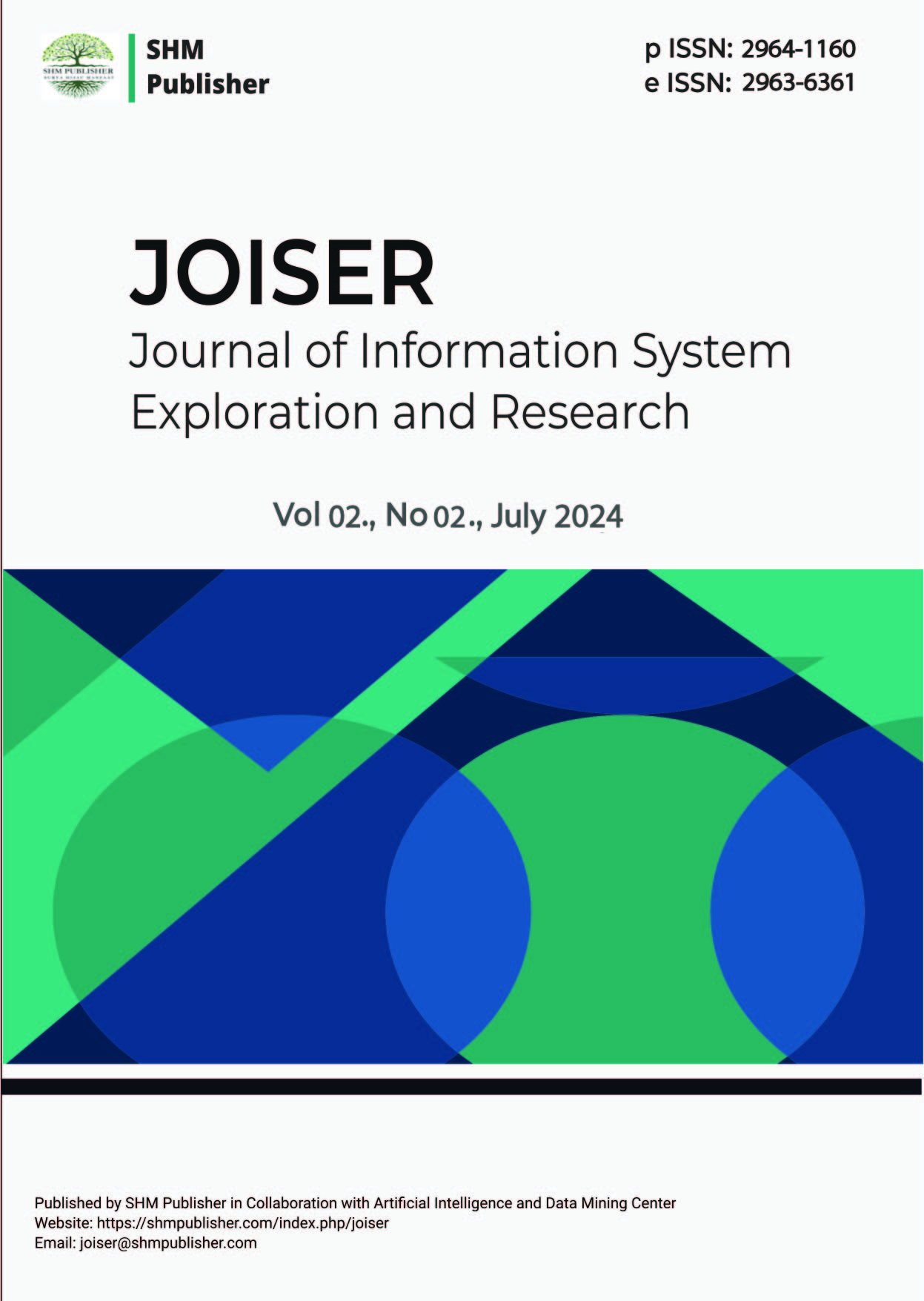Inception ResNet v2 for Early Detection of Breast Cancer in Ultrasound Images
Main Article Content
Abstract
Breast cancer is one of the leading causes of death in women. Early detection through breast ultrasound images is important and can be improved using machine learning models, which are more accurate and faster than manual methods. Previous research has shown that the use of the CNN (Convolutional Neural Network) algorithm in breast cancer detection still does not achieve high accuracy. This study aims to improve the accuracy of breast cancer detection using the Inception ResNet v2 transfer learning method and data augmentation. The data is divided into training, validation and testing data consisting of 3 classes, namely Benign, Malignant and Normal. The augmentation process includes rotation, zoom, and rescale. The model trained using CNN and Inception ResNet v2 showed good performance by producing the highest accuracy of 89.72% in the training data evaluation data and getting 90% accuracy in the prediction test stage with data testing. This study shows that the combination of data augmentation and the Inception ResNet v2 architecture can improve the accuracy of breast cancer detection in CNN models.
Article Details

This work is licensed under a Creative Commons Attribution-ShareAlike 4.0 International License.
References
Kemenkes RI, “Jika Tidak Dikendalikan 26 Juta Orang Di Dunia Menderita Kanker,” Kemenkes RI. Accessed: Jul. 27, 2024. [Online]. Available: http://www.kemenkes-ri.htm/
Etinosa Yvonne, “Breast cancer,” World Health Organization (WHO). Accessed: Jul. 27, 2024. [Online]. Available: https://www.who.int/news-room/fact-sheets/detail/breast-cancer
A. B. Nassif, M. A. Talib, Q. Nasir, and F. M. Dakalbab, “Machine learning for anomaly detection: A systematic review,” Ieee Access, vol. 9, pp. 78658–78700, 2021.
M. Desai and M. Shah, “An anatomization on breast cancer detection and diagnosis employing multi-layer perceptron neural network (MLP) and Convolutional neural network (CNN),” Clinical eHealth, vol. 4, pp. 1–11, 2021, doi: https://doi.org/10.1016/j.ceh.2020.11.002.
C. B. Gonçalves, J. R. Souza, and H. Fernandes, “Classification of static infrared images using pre-trained CNN for breast cancer detection,” in 2021 IEEE 34th International Symposium on Computer-Based Medical Systems (CBMS), 2021, pp. 101–106. doi: 10.1109/CBMS52027.2021.00094.
P. Wang, E. Fan, and P. Wang, “Comparative analysis of image classification algorithms based on traditional machine learning and deep learning,” Pattern Recognit Lett, vol. 141, pp. 61–67, 2021.
B. Zeimarani, M. G. F. Costa, N. Z. Nurani, S. R. Bianco, W. C. D. A. Pereira, and C. F. F. Costa Filho, “Breast lesion classification in ultrasound images using deep convolutional neural network,” IEEE Access, vol. 8, pp. 133349–133359, 2020.
M. Ahmed, A. AlZoubi, and H. Du, “Improving Generalization of ENAS-Based CNN Models for Breast Lesion Classification from Ultrasound Images,” in Medical Image Understanding and Analysis, B. W. Papież, M. Yaqub, J. Jiao, A. I. L. Namburete, and J. A. Noble, Eds., Cham: Springer International Publishing, 2021, pp. 438–453.
C. Peng, Y. Liu, X. Yuan, and Q. Chen, “Research of image recognition method based on enhanced inception-ResNet-V2,” Multimed Tools Appl, vol. 81, no. 24, pp. 34345–34365, 2022.
J. Wang, X. He, S. Faming, G. Lu, H. Cong, and Q. Jiang, “A real-time bridge crack detection method based on an improved inception-resnet-v2 structure,” IEEE Access, vol. 9, pp. 93209–93223, 2021.
C. Chen and F. Qi, “Single image super-resolution using deep CNN with dense skip connections and inception-resnet,” in 2018 9th international conference on information technology in medicine and education (ITME), IEEE, 2018, pp. 999–1003.
S. M. Badawy, A. E.-N. A. Mohamed, A. A. Hefnawy, H. E. Zidan, M. T. GadAllah, and G. M. El-Banby, “Classification of Breast Ultrasound Images Based on Convolutional Neural Networks-A Comparative Study,” in 2021 International Telecommunications Conference (ITC-Egypt), IEEE, 2021, pp. 1–8.
R. Karthik, R. Menaka, G. S. Kathiresan, M. Anirudh, and M. Nagharjun, “Gaussian dropout based stacked ensemble CNN for classification of breast tumor in ultrasound images,” Irbm, vol. 43, no. 6, pp. 715–733, 2022.
A. Anton, N. F. Nissa, A. Janiati, N. Cahya, and P. Astuti, “Application of deep learning using convolutional neural network (CNN) method for Womenâ€TM s skin classification,” Scientific Journal of Informatics, vol. 8, no. 1, pp. 144–153, 2021.
R. Sayuti, Convolutional Neural Networks Untuk Visi Komputer, 1 ed. deepublish, 2021.
M. Jogin, M. S. Madhulika, G. D. Divya, R. K. Meghana, and S. Apoorva, “Feature extraction using convolution neural networks (CNN) and deep learning,” in 2018 3rd IEEE international conference on recent trends in electronics, information & communication technology (RTEICT), IEEE, 2018, pp. 2319–2323.
F. Indriyani and I. R. Rahadjeng, “Klasifikasi Tumor Otak Berbasis Magnetic Resonance Imaging Menggunakan Algoritma Convolutional Neural Network,” Digital Transformation Technology, vol. 3, no. 2, pp. 918–924, 2023.
C. Szegedy, S. Ioffe, V. Vanhoucke, and A. Alemi, “Inception-v4, inception-resnet and the impact of residual connections on learning,” in Proceedings of the AAAI conference on artificial intelligence, 2017.
S. Kumar and A. Mallik, “Covid-19 detection from chest x-rays using trained output based transfer learning approach,” Neural Process Lett, vol. 55, no. 3, pp. 2405–2428, 2023.
M. Neshat, M. Ahmed, H. Askari, M. Thilakaratne, and S. Mirjalili, “Hybrid Inception Architecture with Residual Connection: Fine-tuned Inception-ResNet Deep Learning Model for Lung Inflammation Diagnosis from Chest Radiographs,” Procedia Comput Sci, vol. 235, pp. 1841–1850, 2024.
C. Do and L. Vu, “An approach for recognizing COVID-19 cases using convolutional neural networks applied to CT scan images,” in Applications of Digital Image Processing XLIII, SPIE, 2020, pp. 719–727.
M. HeK and Q. RenS, “Deep residual learning for image recognition,” in 2016 IEEE Conference on Computer Vision and Pattern Recognition, 2016, pp. 770–778.

